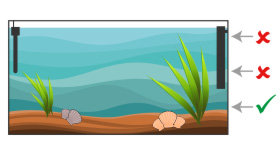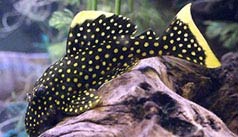

Alternative species (click on the thumbnail to see the card)
Names
Scientific name
Hypostomus plecostomus
Acipenser plecostomus
Common name
Common pleco
Suckermouth catfish)
Origin

Origin: South America
Biotope: Amazonian
Dimorphism

The male has more developed pectoral fins. The female is usually lighter than the male
Group

Loricariidae
Volume

400 L / 88 imp gal / 106 US gal
parameters

T°: 20 à 28°C or68 to 82°F
pH: 6 to 8
Hardness: 1 to 15°dGH
Difficulty

Easy
Size

35 cm (14")
Longevity

15 to 20 years
Living zone

Depth
Individuals

2
Food
How to feed the Common pleco?
Food
How to feed the Common pleco?
The common pleco is omnivorous, essentially vegetarian. It will accept without difficulty bottom pellets based on spirulina but a contribution of fresh food will be a real plus: salad, cucumber, green beans, zucchini, spinach... Vary its diet by offering worms or shrimps.
Behavior
What kind of behavior does the Common pleco have?
Behavior
What kind of behavior does the Common pleco have?
The Suckermouth catfish is a rather peaceful fish that evolves mainly at night. Sometimes it can pursue its roommates to defend its territory, especially other Loricaridae. As it gets older, the Pleco becomes more and more aggressive and territorial. Therefore, think carefully before adopting it!
Cohabitation
Who can live with the Common pleco?
Cohabitation
Who can live with the Common pleco?
Because of its large size and peaceful nature, associate the common pleco with large species such as Scalars or Oscars. It is also one of the only fish compatible with piranhas.
In contrast, avoid cohabitation with other bottom species like Corydoras that could be hurt by this depth giant.
Cohabitation with goldfish is impossible.
Breeding
How to breed the Common pleco?
Breeding
How to breed the Common pleco?
Breeding is quite difficult to achieve in the aquarium (most farmers use ponds provided for this purpose). The Suckermouth catfish lays clusters of hundreds of eggs (200/300) in recesses or cavities. Roots or PVC pipes can be used as laying surfaces. Opt for a pH of 6.5 and a good brewing.
It is the male who takes care of the eggs by ventilating them and sorting them (it removes the moldy eggs). At birth, the fry measure 5 mm (0.2 inches) and their growth is very slow (count several months for a few centimeters).
The young feed on the algae of the aquarium, so you need a good reserve!
Its aquarium
Which aquarium for the Common pleco?
Its aquarium
Which aquarium for the Common pleco?
As for all bottom species, install a non-cutting substrate, if possible large enough grain size (otherwise your sand will be scattered in the water each time the fish moves). Provide enough free space for it to move around at its ease.
Also add big roots and flat rocks to the aquarium because the Suckermouth catfish likes to rest in the shade or in cavities during the day (make sure however the stability of your decoration, even if you stick the rocks between them).
Plantation side, you do not risk anything until the Pleco reaches 10/15 cm or 4/6 inches. Once this size is reached, it may be difficult to maintain proper planting because the Pleco tends to be destructive. You can in this case pass on a vegetation composed of tough and very firmly anchored plants (as the Anubias for example).
The common pleco produces a lot of waste. Regularly vacuum excrement and change 30 to 50% of the water a week.
Good To know
Find all additional information!
Good To know
Find all additional information!
Its mouth in the shape of a suction cup allows it to fix itself to the windows and the decoration. It scrapes the micro-algae found on these supports. It is for this reason that it is often sold as a «cleaner». Yet, nocturnal, territorial and huge, this fish is poorly adapted to most aquariums. In addition, its ability to scrape algae fades with age. Indeed, it will eat seaweed only during its youth.
As with all fish, its purchase should be motivated by interest in its species, and not for their so-called «function», which is in most cases quite limited. Nothing will replace the maintenance work of the aquarist!
The common pleco is a fairly robust fish and accepts a wide range of water parameters.
There are golden and brown forms of this species.
As it is sold rather small, it is often confused with the Ancistrus. Indeed, it is quite difficult to differentiate between these species when the individuals are young. Plecos do not have the spines found on the Ancistrus’ heads. They are also much bigger. Other differences are at the tail, dorsal fin and head shape:

Yours photos!
Comments
Sort by:
Please login to post comments



